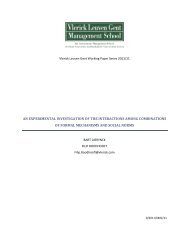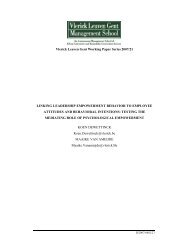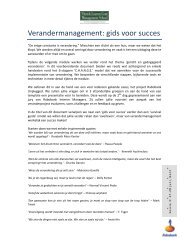Vlerick Leuven Gent Working Paper Series 2007/03 ... - Vlerick Public
Vlerick Leuven Gent Working Paper Series 2007/03 ... - Vlerick Public
Vlerick Leuven Gent Working Paper Series 2007/03 ... - Vlerick Public
Create successful ePaper yourself
Turn your PDF publications into a flip-book with our unique Google optimized e-Paper software.
Second, it can be argued that the models used to study the relationship between the<br />
board of directors and firm performances are incomplete. The literature on boards of directors<br />
is characterized by a near universal focus on studying the direct effects of board<br />
characteristics on performance outcomes while ignoring the influence of potential intervening<br />
variables. In particular, Pettigrew (1992) observed that in mainstream board research: “great<br />
inferential leaps are made from input variables such as board composition to output variables<br />
such as board performance with no direct evidence on the processes and mechanisms which<br />
presumably link the inputs to the outputs” (p.171). More and more, researchers hold this point<br />
of view and are convinced that it is necessary to go beyond the traditional direct approach to<br />
fully understand what boards of directors actually do, how they work, and derivatively, to<br />
what extent they affect performance (Huse, 2005; Huse and Schoning 2004; Finkelstein and<br />
Mooney 20<strong>03</strong>; Daily et.al., 20<strong>03</strong>; Leblanc and Gillies 20<strong>03</strong>; Forbes and Milliken, 1999). This<br />
criticism is however by no means limited to board research. It is also expressed in studies on<br />
demography-performance links in other contexts. In particular, in “upper echelons” research<br />
(Hambrick and Mason, 1984), scholars came to understand that the relationships between Top<br />
Management Team (TMT) demography and organisational outcomes are mediated and/or<br />
moderated by various intervening variables, such as team processes. In their recent review,<br />
Carpenter et.al. (2004) propose and challenge organizational researchers to “carefully explore<br />
the practical and theoretical meaning of TMT demographic characteristics vis-à-vis the deeper<br />
constructs they are presumed to proxy” (p.749). This actually reinforces the call of earlier<br />
authors to omit the use of direct input-output models. Priem et.al. (1999), for example, already<br />
pointed out that upper echelon theories frequently suggest mediating variables (such as group<br />
interaction processes etc.) to explain the influence of TMT heterogeneity on firm<br />
performance, but that these mediators typically remain unmeasured. “Most research<br />
undertaken from a demographics perspective implicitly views TMT processes as a “black<br />
box” that must be inferred because they are impractical to measure or cannot be directly<br />
observed” (p.947). The “black box” of organizational demography has also been described by<br />
Lawrence (1997) in terms of the phenomenon of ‘congruence assumption’. Based on Pfeffer’s<br />
(1983) original discussion, she noted that researchers assume demographic predictors to be<br />
congruent with subjective concepts, which therefore are irrelevant and unnecessary to include.<br />
She makes a strong case to eliminate the congruence assumption to study the actual<br />
mechanisms underlying the demography-outcome relationships.<br />
7










